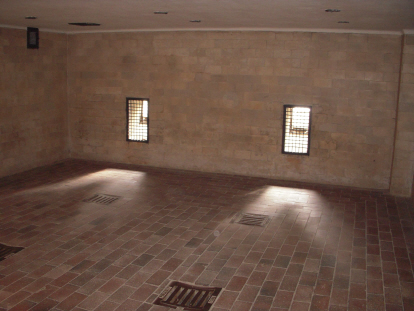
The western side of the Memorial Site is the most sensitive area of all.
Close to the statue of the Unknown Concentration Camp Inmate is a small shed.

Plate 30: The first Dachau crematorium (contemporary photograph)
Contained within this shed is a double muffle oven supplied by the German engineering firm J.A. Topf and Sons of Erfurt.
This oven was originally designed for mobile use, but was walled in at Dachau, therefore becoming stationary. The design of the concentration camp ovens highlights the contempt with which the Nazis viewed the prisoners. Concentration camp ovens differed from conventional ovens used in normal funeral proceedings. They had smaller chambers, as coffins were not utilised, with the doors designed so that they could be opened manually and the bodies exposed directly to the flames. It was unimportant to the SS that destruction of the corpse caused smoke and smells. Fuel was often in scarce supply, and using as little fuel as possible was more important than black smoke and sparks emerging from the crematorium chimney as the corpses of inmates were destroyed.86

Plate 31: Double muffle oven inside the first Dachau crematorium (contemporary photograph)
As the number of deaths in Dachau Concentration Camp increased, this small crematorium became overwhelmed. Plans were therefore implemented for the construction of a far more sophisticated building, which would be capable of processing living and dead prisoners.
The Nazis designed this building, which stands opposite the first small crematorium as Dachau’s own murder factory, known as Baracke X. This building could accommodate the disinfection of prisoner clothing, the gassing of prisoners and a morgue where gold could be harvested from the mouths of the dead. The new building was also designed and built to house additional crematorium ovens.

Plate 32: Baracke X (contemporary photograph)
The gas chamber at Dachau Concentration Camp was not used for mass murder, although the test gassing and the inherent murder of prisoners did occur.87 The gas chamber was designed and built to hold around 150 prisoners. In the opinion of Stanislav Zamecnik, author of That Was Dachau: 1933-1945, the gas chamber was certainly used, ostensibly to test that it would work and in connection with the medical experiments of SS Doctor Sigmund Rascher. A former prisoner, Doctor Blaha, testified after the war that he was sent into the gas chamber at Dachau in 1944 on the instruction of Rascher and ‘of the eight people he found there, two were dead, three unconscious, and three had collapsed in a sitting position’.88

Plate 33: Ovens inside Baracke X (contemporary photograph)
The use of the gas chamber at Dachau raises difficult and very sensitive issues, as Zamecnik writes in his book. This gas chamber was used to murder prisoners, but it was not used on a huge scale. This was because Dachau already had access to a gas chamber at Castle Hartheim near Linz in Austria, where prisoners selected as a result of the action Sonderbehandlung (Special Action) 14 f 13 were taken. This action was closely linked with and followed the T4 euthanasia programme that had already murdered 70,243 German people by the summer of 1941.89 Doctors from the T4 programme were used within the concentration camps to weed out prisoners deemed undesirable.
The first prisoners in the sights of the T4 doctors were ‘a-socials’. However, new groups also became the subject of selections – these were the prisoners who were too weak to work, and other prisoners who were racially or politically despised by the Nazis and selected to be murdered. Selections were completed under the charade of a medical examination. Importantly, the prisoners were tricked into believing that the examination would lead to a period in a rest camp.

Plate 34: The gas chamber inside Baracke X (contemporary photograph)
In Dachau one such selection required that ‘all camp inmates were marched in goose-step past doctors at roll call.’90 Those prisoners who were selected as part of 14 f 13 were taken from protective custody within Dachau Concentration Camp to its own de facto gas chamber at Castle Hartheim where the murders of 2,674 prisoners were carried out.91